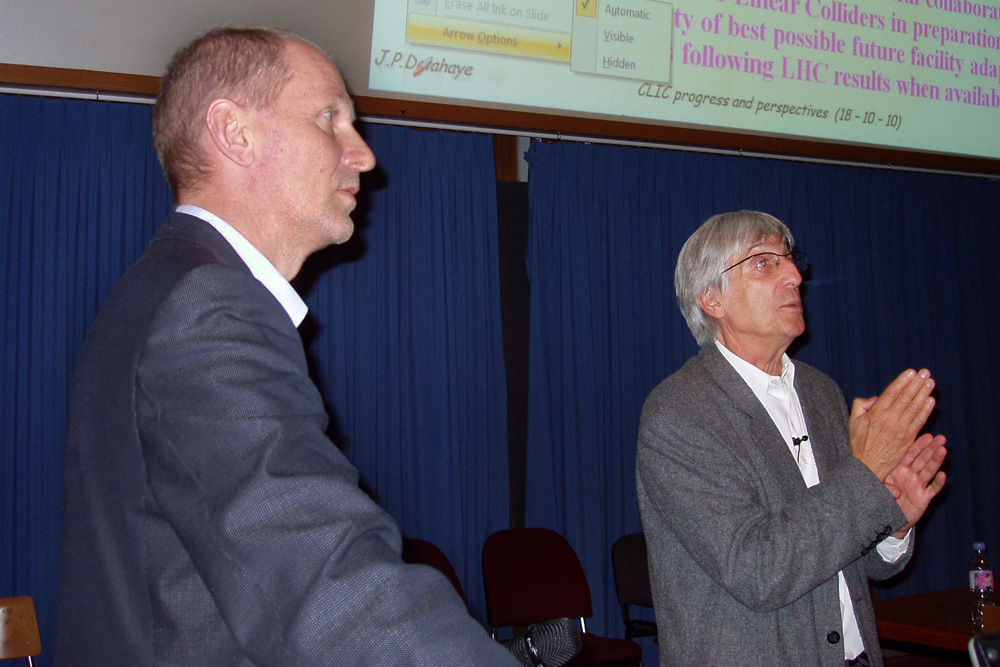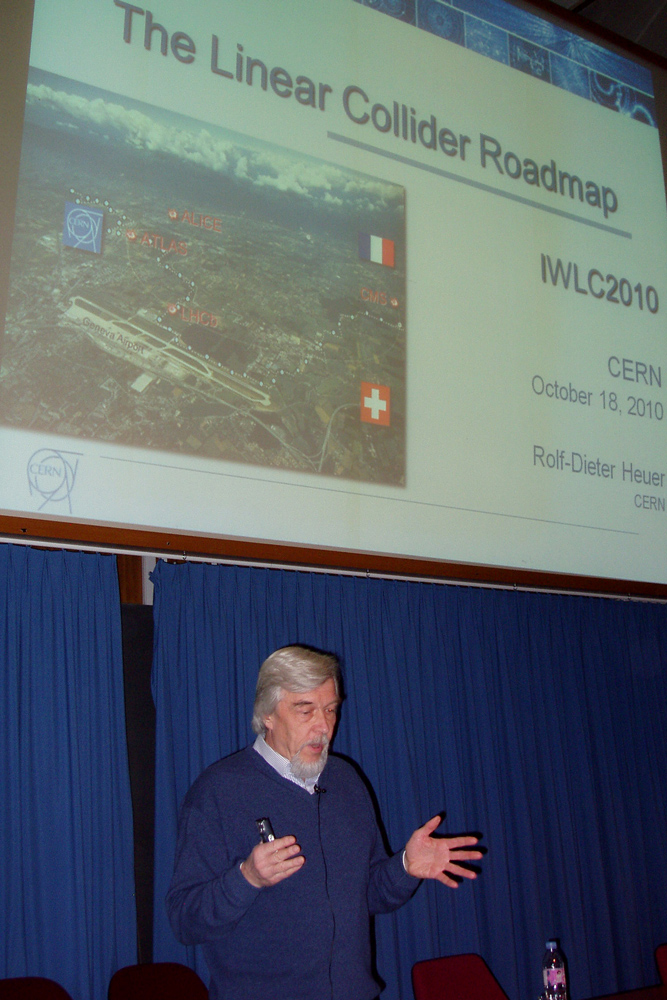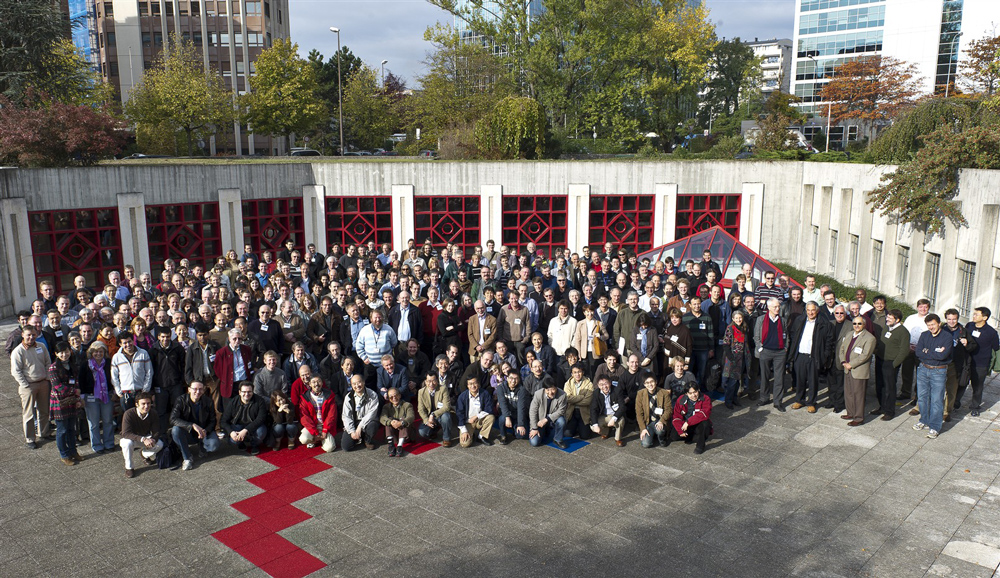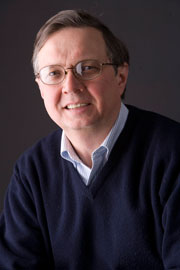Director's Corner
28 October 2010
The first joint ILC and CLIC workshop, IWLC10 in Geneva
Today's issue features a Director's Corner from Peter H. Garbincius, Global Design Effort Cost Manager.
The International Linear Collider community has typically held major meetings twice a year where the accelerator and physics & detector people come together, both to review the status of and make progress in their own disciplines, and to work together in areas of mutual concern, such as the beam and luminosity requirements to attain the desired science goals. This year, the International Workshop on Linear Colliders (IWLC2010), organised by the European Committee for Future Accelerators (ECFA), was noteworthy in that it was the first joint workshop for both ILC and CLIC – an electron-positron Compact Linear Collider Study based on room-temperature radio frequency technology operating at three teraelectronvolts (TeV) – including the accelerator and detector & physics groups for both the ILC and for CLIC. A few CLIC and ILC people have typically participated in the meetings of each other's programme, such at the annual CLIC Workshop typically held at CERN and the Linear Collider Workshop last March in Beijing, but this meeting featured the integration of both groups. The mutual interest in both ILC and CLIC attracted 479 registered participants, which surpassed CERN's capacity. The parallel sessions, up to 16 at a time, were held in the beautiful and functionally impressive International Conference Center Geneva (CICG) near the United Nations complex.
 Steinar Stapnes (left) and Jean-Pierre Delahaye answering questions on CLIC R&D programme. Image: Peter Garbincius Steinar Stapnes (left) and Jean-Pierre Delahaye answering questions on CLIC R&D programme. Image: Peter Garbincius |
I can only provide a brief summary, concentrating on the topics I considered most important (check also the IWLC2010 conference website, and the IWLC2010 workshop timetable, along with links to most of the presentations). Scheduled activities and satellite meetings actually started a half-day before the workshop formally began and continued throughout. The Conventional Facility Groups visited the LHC cryogenic plant installation and toured the Mont Blanc tunnel with emphasis on its state-of-the-art life safety systems. Steinar Stapnes presented "Towards a Future Linear Collider" specifically as a pre-introduction for CERN staff. In the spring of 2011, Stapnes will become CERN's Linear Collider Study Leader, succeeding Jean-Pierre Delahaye, current CLIC Study Leader. The change in title acknowledges that many linear collider activities are common between ILC and CLIC and expresses CERN's intention to work towards these common goals.
 CERN DG Rolf Heuer emphasising that results from the LHC will be upon us quickly and that we should continue to prepare right now to make the best case for a linear collider. Image: Peter Garbincius CERN DG Rolf Heuer emphasising that results from the LHC will be upon us quickly and that we should continue to prepare right now to make the best case for a linear collider. Image: Peter Garbincius |
The keynote address "The LC Roadmap" was presented by CERN Director General Rolf Heuer. Heuer described the impressive progress of the LHC and its experiments, including the science results that could be anticipated over the next few years, since the Linear Collider Workshop in Beijing last March, just before the start of the 7-TeV LHC run. It is widely agreed that a linear collider using lepton beams, like the ILC or CLIC, would be an appropriate next machine to further investigate and to exploit the discoveries of the LHC. Heuer outlined the steps necessary over the next few years to reach a decision to build one of these machines, based on whichever machine's energy range is favoured by the observed LHC. These steps included preparing and documenting the designs, a realistic cost estimate, and the case for a linear collider, assessing the emerging physics scenario from the LHC, providing a mechanism for the site decision, and suggesting appropriate governance models for this project and facility.
After that rousing and inspirational start, the physics prospects of linear colliders and the status of the ILC and CLIC accelerators, the ILD and SiD and CLIC detectors, and detector R&D were reviewed in the joint plenary session. The next three days were filled with parallel sessions, roughly divided into common and interspersed ILC and CLIC accelerator sessions and physics & detector sessions. There were special presentations and interactions between the Accelerator and Physics & Detector teams, including a panel discussion on the scientific requirement for the ability to widely vary the machine energy to scan over energy thresholds, e.g. for the Higgs, or to focus on narrow resonances, e.g. t-tbar, while maintaining adequate luminosity, along with still preliminary plans for both ILC and CLIC to provide this capability. This will be a major topic for consideration at the upcoming ILC Baseline Assessment Workshop at SLAC in January 2011.
 Andrei Seryi, Daniel Schulte, Jim Brau, and Brian Foster (left-to-right), discuss the need to vary the machine energy at ILC and CLIC. Image: Peter Garbincius Andrei Seryi, Daniel Schulte, Jim Brau, and Brian Foster (left-to-right), discuss the need to vary the machine energy at ILC and CLIC. Image: Peter Garbincius |
 The International Workshop on Linear Colliders 2010 group photo. Image: CERN. High-resolution file The International Workshop on Linear Colliders 2010 group photo. Image: CERN. High-resolution file |
The Accelerator and Physics & Detector Working Groups each had individual summary plenary sessions on Friday morning at the International Conference Center Geneva. At the massed plenary back at CERN, ILC Global Design Effort Director Barry Barish, the ILC Research Director Sakue Yamada, and the chair of the CLIC Collaboration Board Ken Peach, reviewed their projects' statuses, progress at this workshop and plans for the future.
Philippe Lebrun from CERN reviewed the organisation, accomplishments, and plans of the formally constituted joint CLIC-ILC Working Groups on Physics & Detectors, Beam Delivery System & Machine Detector Interface, Civil Engineering & Conventional Facilities, Positron Generation, Damping Rings, Beam Dynamics, Cost & Schedule, and Accelerator General Issues, plus the activities of other less formally organised collaborative effort, for example on radiofrequency power systems.
In the final presentation, Sergio Bertolucci concluded that an international scientific project like the linear collider is a great way to foster mutual cooperation both on a regional and a global basis. Our need to preserve the culture of high-energy physics should lead to even further combination and integration of ILC and CLIC. We were left recalling Heuer's call for preparedness, flexibility, and visionary global policies.
-- Peter Garbincius
